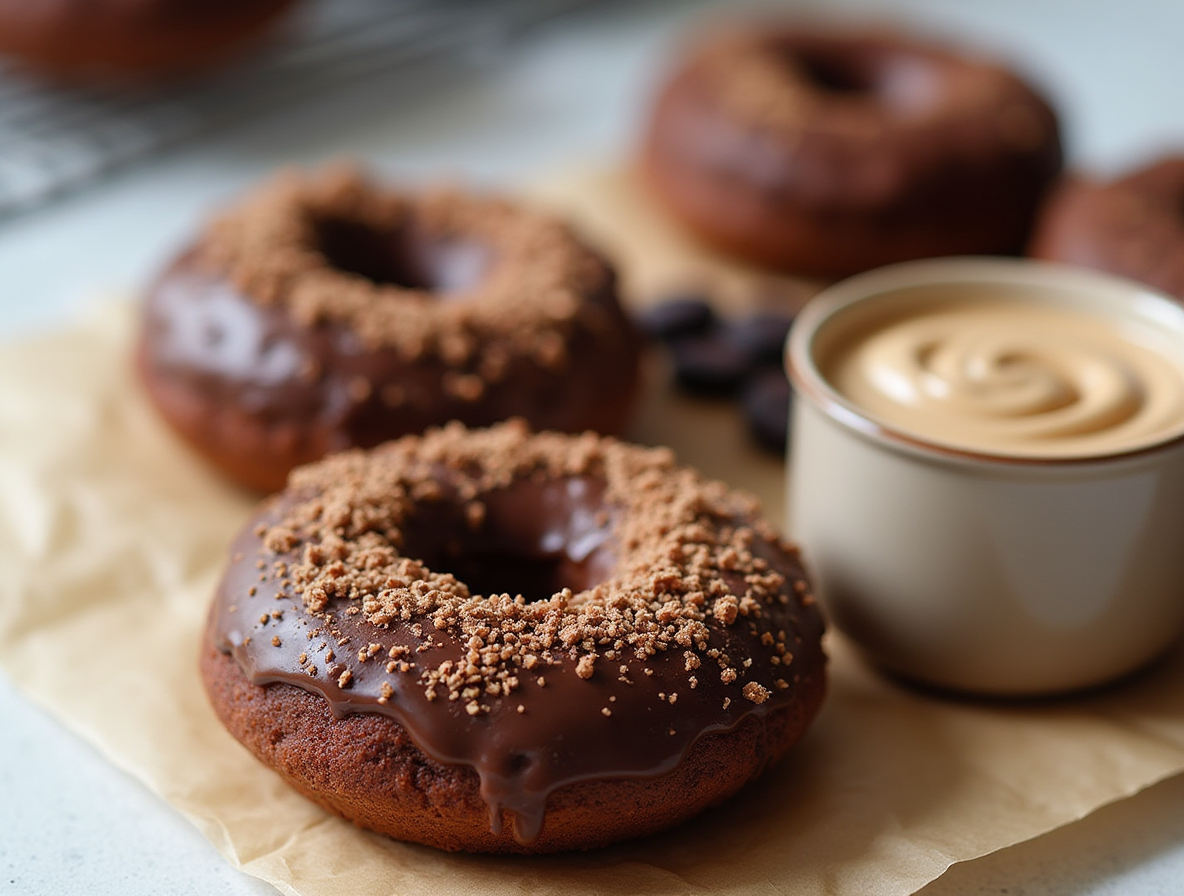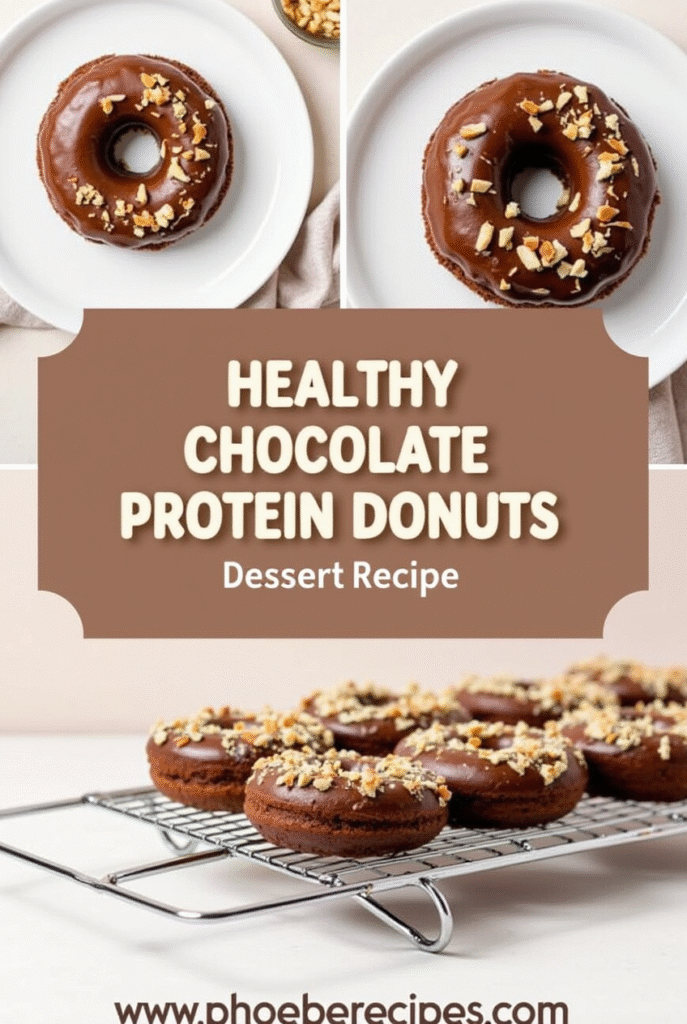Protein Chocolate Donuts: A Chef’s Guide to Guilt-Free Treats
Protein chocolate donuts offer a guilt-free way to satisfy sweet cravings while getting 10 grams of protein per serving. When I first developed this recipe, I wanted to create something that tasted indulgent but still aligned with fitness goals. After all, who says donuts can’t be nutritious?
These chocolate protein donuts contain under 100 calories each and can be prepared in less than 30 minutes using just six ingredients. Additionally, they’re gluten-free, dairy-free, and paleo-friendly, making them accessible for various dietary needs. By using wholesome ingredients like oat flour and avoiding refined sugars, our high protein chocolate donuts recipe delivers all the satisfaction without the guilt. Most importantly, these healthy chocolate donuts are baked instead of fried, significantly reducing the fat content compared to traditional versions.
In this guide, I’ll share everything you need to know about creating perfect protein powder donuts at home. From ingredient selection to baking techniques, you’ll soon be enjoying these nutritious treats that can be stored for up to a week—perfect for meal prep or post-workout snacking.
Why Protein Chocolate Donuts Are Worth Making
Making protein chocolate donuts at home offers numerous advantages beyond just satisfying your sweet tooth. These tasty treats deliver impressive nutritional benefits while keeping your kitchen routine simple and enjoyable.
Healthier than traditional donuts
Unlike conventional donuts that rely on refined sugars and unhealthy fats, protein chocolate donuts provide substantial nutritional value. The typical protein donut contains between 10-12 grams of protein per serving while keeping calories remarkably low—usually between 99-120 calories each. Moreover, their macronutrient profile is impressively balanced with approximately 30% protein, 49% carbs, and 21% fat.
What makes these donuts particularly beneficial is their ability to stabilize blood sugar levels. The added protein helps curb the typical blood sugar spike you’d experience with traditional sugary treats. Furthermore, since they’re baked rather than deep-fried, these donuts contain significantly less fat without sacrificing flavor or texture.
Perfect for post-workout snacks
Protein plays a crucial role in muscle recovery and growth, making these donuts an excellent post-exercise option. Following a workout, your body requires amino acids—the building blocks of protein—to repair and rebuild muscle tissue. These chocolate protein donuts deliver precisely what your body needs during this critical recovery window.
Beyond muscle repair, increasing protein intake becomes especially important as we age since our bodies absorb fewer amino acids from regular foods. These amino acids support not just muscle growth but also immune health, brain function, and hormone regulation. Consequently, enjoying a protein-packed donut after exercise provides both satisfaction and functional benefits your body will appreciate.
Quick and easy to bake at home
Perhaps the most practical advantage of homemade protein chocolate donuts is their simplicity. Most recipes require just one mixing bowl and come together in under 30 minutes. First-time bakers will appreciate that these donuts don’t need yeast or lengthy rising times—unlike traditional donut recipes that can be time-consuming and technically challenging.
Storage is equally convenient; these protein-rich treats maintain their moisture and flavor when properly stored. They typically keep for up to 5 days in an airtight container at room temperature or can be refrigerated for 4-5 days. For long-term planning, you can even freeze them for up to six months, making them perfect for meal prep and busy lifestyles.
The versatility of protein donuts extends to dietary preferences as well. You can easily adapt recipes to accommodate gluten-free, dairy-free, and paleo lifestyles, ensuring everyone can enjoy these nutritious treats regardless of dietary restrictions.
Essential Ingredients for High Protein Chocolate Donuts
Selecting quality ingredients makes all the difference when crafting protein chocolate donuts that taste indulgent while delivering nutritional benefits. The right components ensure your donuts maintain perfect texture, flavor, and protein content.
Choosing the right protein powder
The protein powder you select will significantly impact your donuts’ texture and taste. Casein, vegan protein, or blends work best for baking as they retain moisture when heated. Importantly, whey protein, collagen, and egg white protein powders should be avoided since they typically dry out during baking. For optimal flavor, chocolate or vanilla varieties complement these donuts perfectly, with chocolate naturally enhancing the rich taste profile.
Flour options: almond, oat, or self-rising
Each flour type offers unique benefits for protein chocolate donuts. Almond flour provides a subtle nutty flavor and contains healthy monounsaturated fats, approximately 21% protein, and fewer carbohydrates than other options. Alternatively, oat flour delivers a milder taste with about 17% protein content and 10% fiber, making it excellent for creating fluffy baked goods. For those seeking convenience, self-rising flour combined with yogurt creates an incredibly simple two-ingredient base.
Sweeteners and healthy fats
Natural sweeteners create guilt-free donuts without refined sugar. Maple syrup adds perfect sweetness while keeping the glycemic impact low. Other excellent options include honey, agave syrup, or keto-friendly maple alternatives. For fats, almond butter provides a delicate flavor profile plus healthy fats, though peanut butter or sunflower seed butter work well for those with nut allergies.
Optional glaze and toppings
A nutritious chocolate glaze elevates protein donuts without derailing their health benefits. Combine unsweetened cocoa powder with maple syrup, melted coconut oil, and a splash of milk for a simple yet decadent topping. For variety, try peanut butter drizzle, Greek yogurt frosting, or melted dark chocolate. Sprinkle with crushed nuts, toasted coconut, or even supernatural rainbow sprinkles for added texture and visual appeal.
Step-by-Step Protein Chocolate Donuts Recipe
Creating perfect protein chocolate donuts requires precision and attention to detail. Let’s break down this straightforward baking process into manageable steps that deliver consistent results every time.
1. Mix wet and dry ingredients separately
Initially, gather two mixing bowls—one for wet ingredients and another for dry components. In the first bowl, whisk together eggs, maple syrup, coconut oil, and vanilla extract until fully combined. For enhanced moisture, consider adding Greek yogurt or nut butter to the wet mixture. In your second bowl, combine the dry ingredients: your chosen protein powder, flour (almond, oat, or self-rising), cocoa powder, and baking powder. This separate mixing technique prevents clumping and ensures even distribution of leavening agents.
2. Combine and adjust batter consistency
Next, fold the dry ingredients into the wet mixture, stirring until no flour clumps remain. Be cautious not to overmix, as this can make your donuts tough. The batter should have a thick yet pourable consistency—similar to cake batter. If it appears too dense, gradually add milk or water until you achieve the desired texture. Conversely, if your batter seems too thin, incorporate additional flour to thicken it.
3. Fill donut pan and bake
Before filling your pan, preheat your oven to 350°F (180°C) and thoroughly grease each cavity with cooking spray or oil. Subsequently, transfer your batter into the donut molds using either a piping bag, a ziplock bag with the corner snipped off, or simply spoon it in. Fill each cavity approximately two-thirds full to allow room for rising. Bake for 10-15 minutes or until a toothpick inserted comes out clean and the tops feel firm to touch.
4. Cool and glaze
Once baked, allow the donuts to cool in the pan for about 10 minutes. Afterward, carefully transfer them to a wire rack to cool completely. Meanwhile, prepare your glaze by combining powdered sugar with cocoa powder and gradually adding milk until smooth. For a healthier alternative, mix melted dark chocolate with coconut oil for a silky, rich topping. Finally, dip the cooled donuts top-side down into your glaze and place them back on the rack to set. Add optional toppings like sprinkles while the glaze is still wet.
Ways to Customize Your Donuts
The beauty of homemade protein chocolate donuts lies in their endless customization possibilities. Once you’ve mastered the basic recipe, you can experiment with different flavors, dietary adaptations, and creative toppings to keep your treats exciting and tailored to specific preferences.
Flavor variations: vanilla, blueberry, funfetti
For vanilla protein donuts, simply omit the cocoa powder from your base recipe and add an extra teaspoon of vanilla extract or vanilla bean paste. These lighter-colored donuts provide the perfect canvas for colorful toppings and glazes.
Blueberry protein donuts combine tender cake texture with juicy berries and sweet vanilla glaze. Add approximately ½ cup of fresh or thawed frozen blueberries to your batter. For frozen berries, microwave them briefly before adding to remove excess liquid that might affect the batter consistency.
Funfetti donuts bring nostalgic birthday cake vibes to your protein treats. These colorful donuts are light, fluffy, and full of flavor – they won’t dry out like many protein-baked goods often do. Simply fold 1-3 tablespoons of rainbow sprinkles into your vanilla donut batter before baking.
Vegan and low-carb adaptations
Creating vegan protein donuts requires a few strategic substitutions. Replace eggs with either flax eggs (1 tablespoon ground flax plus 3 tablespoons water), 4 tablespoons of applesauce, or a store-bought egg replacer. Dairy ingredients can be swapped with plant-based alternatives – use coconut, oat, or soy milk for the batter and dairy-free yogurt in place of Greek yogurt.
For low-carb variations, substitute regular flour with almond flour combined with coconut flour to reduce carbohydrates. Replace traditional sweeteners with sugar-free alternatives like erythritol, monk fruit, or allulose that measure like sugar.
Creative glaze ideas
Elevate your protein donuts with distinctive glazes and toppings. For a classic chocolate glaze, combine cocoa powder with maple syrup, melted coconut oil, and a splash of milk. A protein-packed frosting option combines Greek yogurt with a touch of honey or maple syrup.
Alternatively, try a fruity raspberry glaze or peanut butter drizzle for unique flavor combinations. For added texture and visual appeal, consider toppings like crushed nuts, toasted coconut, chocolate chips, or even fruity cereal for a playful twist.
Conclusion
Protein chocolate donuts truly transform the concept of “guilty pleasure” into a nutritious indulgence. Throughout this guide, we’ve explored how these treats deliver approximately 10 grams of protein per serving while keeping calories under 100. Most importantly, they provide all the satisfaction of traditional donuts without compromising your fitness goals.
The versatility of these donuts stands out as one of their greatest strengths. Whether you prefer classic chocolate, vanilla, blueberry, or funfetti variations, the basic recipe adapts beautifully to your taste preferences. Additionally, their adaptability extends to dietary restrictions, making them accessible for everyone regardless of their nutritional needs.
Making these donuts requires minimal effort—just 30 minutes from start to finish with ingredients you likely already have at home. This simplicity, combined with their storage flexibility, makes them perfect for busy lifestyles. You can prepare a batch during weekend meal prep and enjoy them throughout the week as post-workout rewards or quick breakfast options.
The nutritional profile of these treats certainly deserves attention. Unlike conventional donuts laden with refined sugars and unhealthy fats, our protein version offers balanced macronutrients while helping stabilize blood sugar levels. Furthermore, the protein content aids muscle recovery, making these donuts functional as well as delicious.
My journey creating these protein chocolate donuts began with a simple question: “Why can’t treats be nutritious?” Now I invite you to experience the satisfaction of baking your own batch. After all, food should nourish both body and soul—these donuts accomplish both without compromise. Your kitchen awaits this delicious adventure that proves healthy eating never means sacrificing joy.
FAQs
Q1. How many calories are in a protein chocolate donut? Typically, a protein chocolate donut contains under 100 calories per serving, making it a guilt-free treat compared to traditional donuts.
Q2. Can I make protein donuts without a donut pan? While a donut pan is ideal, you can use a muffin tin as an alternative. The shape will be different, but the taste and nutritional benefits remain the same.
Q3. Are protein donuts suitable for people with dietary restrictions? Yes, protein donuts can be easily adapted for various dietary needs. They can be made gluten-free, dairy-free, and even vegan with simple ingredient substitutions.
Q4. How long do homemade protein donuts stay fresh? When stored properly in an airtight container, protein donuts can last up to 5 days at room temperature or 4-5 days in the refrigerator. They can also be frozen for up to six months.
Q5. What’s the best protein powder to use for baking donuts? For baking protein donuts, casein, vegan protein, or protein blends work best as they retain moisture when heated. Avoid whey protein, collagen, and egg white protein powders as they tend to dry out during baking.


